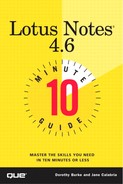Creating Mail
The most common type of mail message is the memo. It's a good idea to keep mail messages as short as possible—this helps ensure that recipients read your messages. Notes mail messages can contain formatted text, tables, graphics, attachments, graphs, and embedded information.
You can create mail messages from any area of Notes, even when you are working in other databases. To create a mail message, do the following:
If you are in your Mail database, click the New Memo button on the Action bar. A blank memo, like the one in Figure 7.1, appears. Notes automatically fills in your name, the date, and the time.
If you are at the Notes workspace or in another database, choose Create, Memo from the menu. A blank memo appears, like the one in Figure 7.1
Click in the To brackets and enter the name(s) of the person(s) to whom you want to send the memo. Separate names with a comma. As you type a name, Notes searches your company's address book and your Personal Address Book for the letters you've typed. If it finds a match, Notes fills in the name for you. This is called the quick address feature of Notes. If Notes fills in a name you do not want, continue to type. Notes searches for the next match. Quick address can be turned off if you don't like this feature. See "Creating Location Documents" in Lesson 22, "Setting Up for Mobile Use," for more information.
(Optional) Click in the cc (carbon copy) brackets or press the Tab key, and then enter the name(s) of the person(s) to whom you want to send a copy of the message. Again, Notes fills in names for you if it finds the first letters you enter in either address book.
(Optional) Click in the bcc brackets and enter the name(s) of the person(s) to whom you want to send a blind carbon copy.
In the Subject brackets, enter a word or phrase to use as a title for your message. It is extremely important to fill in the Subject line because it appears in the Inbox view, telling the recipient the purpose of your message.
In the body field (the brackets below the Subject line), enter the message you want to send. This field is a rich text field, which means that you can format text, add attachments and graphics, and so forth. When entering the message, follow these guidelines:
Press Enter only when you want to start a new paragraph.
Note
Using Address Books Address Book Notes provides address books used for routing mail. Your company's address book is stored on the Domino server and contains the names of all those people in your Notes network and others to whom your company communicates with via email. Notes also creates a Personal Address Book so that you can enter your own contacts. See Lesson 9, "Using the Address Books," for more information on the Address Books.
If you aren't sure of a person's last name or the spelling, you can look it up in the address book. You can choose to insert the person's name in the To, cc, or bcc fields. To use an address book, follow these steps:
Click the Address button on the Action toolbar.
When the Mail Address dialog box appears, you see a list of names from your Personal Address Book (see Figure 7.2). At this point, your Personal Address Book is probably empty. To access the Public Address Book, click the drop-down menu and select the name of your Public Address Book. Remember, you must be able to connect to the server to access the Public Address Book.
Select the name of the person that you need from the available list of names (to select more than one name, click the margin in front of each name to place a check mark there). You can use the scrollbar to move up or down the list.
Click the To, cc, or bcc button, depending on which address field you want to fill.
Repeat the last two steps for each name you want to enter.
Click OK.
When creating a message, use the mailbox's SmartIcons or menu commands to add emphasis to and change the format of text in your memo. For example, try some of these ideas, using either the appropriate menu commands or the SmartIcons pictured:
You can cut and paste text within the memo as you would in any word processing document. Simply select the text, choose Edit, Cut, position the insertion point in the desired location, and choose Edit, Paste.
Select any text you want to emphasize and click the Bold SmartIcon or the Italic SmartIcon. (You'll learn more about formatting text in Lesson 14, "Editing Text Fields.") Internet email etiquette suggests that you use italics to emphasize text, not bold or all caps.
Check the spelling by choosing Edit, Check Spelling. (Lesson 15, "Working With Text Features," covers the details of using the Spell Checker.)
Align selected text by clicking one of the Text Align SmartIcons. (If you're not sure which SmartIcon is which, use the Help description bubbles that you learned about in Lesson 3, "Navigating Notes.")
Indent selected text by clicking one of the Text Indent SmartIcons. (Again, if you're not sure which SmartIcon is which, use the Help description bubbles.)
Change a list into a bulleted list or a numbered list (respectively) by selecting the text and clicking the appropriate SmartIcon.
Caution
Text Formatting Doesn't Work! Before you can delete, format, or otherwise manipulate text, you must select it. To do so, place the insertion point to the left of the text you want to select. Then, click and drag the mouse over the text to be included, highlighting the text.


